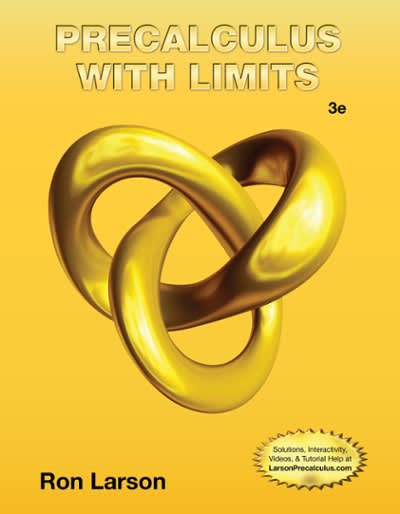Question
1. Assume researchers are trying to find out the mean concentration levels of a specific drug in a population of individuals' blood during a clinical
1. Assume researchers are trying to find out the mean concentration levels of a specific drug in a population of individuals' blood during a clinical trial. The researchers find that the sample population of 40 has a mean concentration of 7.1 mcg/mL with a standard deviation of 1.7 mcg/mL. Calculate a 95% confidence interval for the mean concentration level of the medication for the population's blood and interpret it.
A) The researchers are 95.0% confident the true mean concentration of medication in the population's blood is between 6.573 mcg/mL and 7.627 mcg/mL.
B) The researchers are 95.0% confident the true mean concentration of medication in the population's blood is between 6.235 mcg/mL and 7.165 mcg/mL.
C) The researchers are 95.0% confident the true mean concentration of medication in the population's blood is between 4.568 mcg/mL and 8.832 mcg/mL.
D) The researchers are 95.0% confident the true mean concentration of medication in the population's blood is between 4.5615 mcg/mL and 8.8385 mcg/mL.
2. Assume a researcher wants to compare the mean Alanine Aminotransferase (ALT) levels in two populations, individuals who drink alcohol and individuals who do not drink alcohol. The mean ALT levels for the individuals who do not drink alcohol is 35 with a standard deviation of 15, and 41 individuals were in the sample. The mean ALT levels for individuals who drink alcohol is 73 with a standard deviation of 21, and 43 individuals were in the sample. Construct and interpret a 95% confidence interval demonstrating the difference in means for those individuals who drink alcohol when compared to those who do not drink alcohol.
A) The researchers are 95% confident that the true mean difference in ALT values between the population of drinkers and population of non-drinkers is between 24.22 and 39.78.
B) The researchers are 95% confident that the true mean difference in ALT values between the population of drinkers and population of non-drinkers is between 24.33 and 39.67.
C) The researchers are 95% confident that the true mean difference in ALT values between the population of drinkers and population of non-drinkers is between 30.16 and 45.84.
D) The researchers are 95% confident that the true mean difference in ALT values between the population of drinkers and population of non-drinkers is between 29.43 and 44.57.
3. A researcher has collected the blood samples of 35 individuals and found that the mean hemoglobin concentration for the sample of individuals is 14.6 grams per deciliter and the standard deviation is 1.74 grams per deciliter. Calculate a 95% confidence interval for the mean hemoglobin concentration for the population.
A) (13.36, 14.44)
B) (13.38, 14.42)
C) (10.98, 16.82)
D) (14.02, 15.18)
4. True or False?A clinical trial is conducted to compare an experimental medication to placebo to reduce the symptoms of asthma. One hundred participants are enrolled in the study and randomized to receive either the experimental medication or placebo. The primary outcome is self-reported reduction of symptoms. Among 50 participants who receive the experimental medication, 30 report a reduction of symptoms as compared to 15 participants of 50 assigned to the placebo. The 95% CI for the relative risk of participants reporting a reduction of symptoms between the experimental and placebo groups is between 0.114 and 0.486.
5. True or False? The Confidence Interval is the product of the value that reflects the desired confidence level (e.g.,Z= 1.96 for 95% confidence) and the standard error of the point estimate.
Step by Step Solution
There are 3 Steps involved in it
Step: 1

Get Instant Access to Expert-Tailored Solutions
See step-by-step solutions with expert insights and AI powered tools for academic success
Step: 2

Step: 3

Ace Your Homework with AI
Get the answers you need in no time with our AI-driven, step-by-step assistance
Get Started


